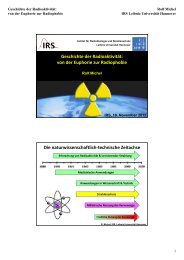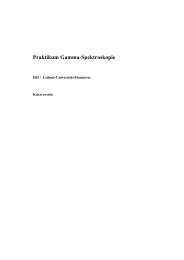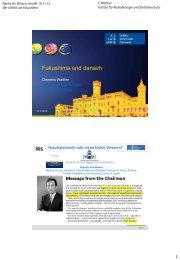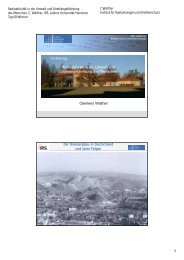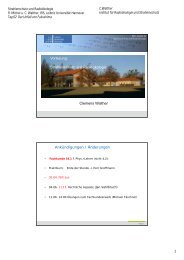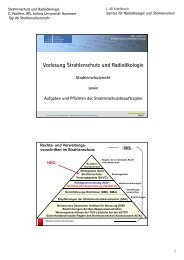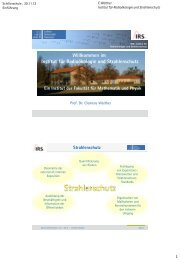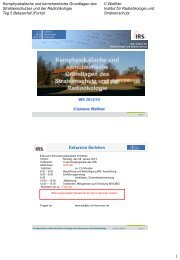Sie wollen auch ein ePaper? Erhöhen Sie die Reichweite Ihrer Titel.
YUMPU macht aus Druck-PDFs automatisch weboptimierte ePaper, die Google liebt.
GLOSSAR 261<br />
Induzierte Emission Stimulated emission Prerequisite for laser action. In addition to spontaneous<br />
photon emission an excited atom can be stimulated to emit a photon by the presence of a<br />
second photon of exactly the excitation energy. The emitted photon has the same properties<br />
as has the stimulating one, which results in monochromatic, coherent light. (Eq. (1.0)) [p. 5]<br />
Inelastische Streuung Inelastic scattering. Scattering process where energy is transferred from the<br />
photon to the scatterer (or vice versa) (Eq. (3.3)) [p. 44]<br />
Interkombinationsverbot Prohibition of intercombination. Transitions between terms of different<br />
multiplicity are forbidden. E.g. transitions from a singulet state to a triplet state can not<br />
be caused by emission or absorption of a photon (Eq. (A.4)) [p. 238]<br />
Kohärenz Coherence. When two beams of light can interact so as to produce interference fringes<br />
the visibility of which is unity, they are said to be perfectly coherent. When their interaction<br />
produces no fringes (but only photometric summation) they are said to be noncoherent or<br />
incoherent. (Eq. (2.67)) [p. 36]<br />
Kramers-Kronig Relation In the framework of the Drude model of electrons oscillating around an<br />
atomic core, the Kramers-Kronig relation quantifies the complex refractive index, i.e. η, the<br />
real index of refraction, andχ the imaginary part which corresponds to the absorptivity.<br />
(Eq. (8.21)) [p. 216]<br />
Laporte-Verbot Laporte-forbidden transitions ‘violate’ parity conservation. I.e. electric dipole transition<br />
between states of equal parity. See also parity. (Eq. (4.18)) [p. 98]<br />
Laser Induced Photoacoustic Spectroscopy See LPAS (Eq. (4.12)) [p. 93]<br />
LIBD Laser Induced Breakdown Detection is a colloid detection method utilising plasma formation<br />
in the high field of a focused laser beam. The size distribution of colloids between 5 nm and<br />
1000 nm of mass concentration down to 10 −9 g dm −3 can be measured, often without sample<br />
pretreatment, both, in the laboratory as well as in field experiments. (Eq. (1.0)) [p. 13]<br />
LIBS Laser Induced Breakdown Spectroscopy. Technique used for the elemental analysis of solids,<br />
liquids and gases. The sample is heated and vaporized by a the focused light of a pulsed laser.<br />
During the cooling of the hot (ionised) gas recombination processes lead to the emission of<br />
ionic and → atomic lines (c.f. atomic emission) which allow the quantitative determination<br />
of element content. (Eq. (1.0)) [p. 13]<br />
LIDAR Light Direction and Ranging (Eq. (1.0)) [p. 13]<br />
LPAS Laser Induced Photoacoustic Spectroscopy. Matter which absorbs light is heated, expands<br />
and causes an acoustic shock wave which can be detetected by a sensitive microphone. The<br />
amplitude of the acoustic signal increases linearly proportionally with the concentration of<br />
absorbers and with the molar absorptivity (or photon absorption cross-section respectively).<br />
By scanning the excitation wavelength an optical absorption spectra is obtained, which in<br />
turn is used to quantify the amount of species present in the sample. LPAS is applicable to<br />
solids and liquids. The detection limit depends on the absorbtivity and is typically 1.5 orders<br />
of magnitude lower than for UV-VIS detection. In contrast to UV-VIS, the measurement is<br />
not disturbed by → scattering signals (e.g. due to colloids) since LPAS does not probe →<br />
extinction but → absorption. (Eq. (4.12)) [p. 93]



